

For some of the background material, I shall rely on last month's item. We need the space this month for current detail. So I hope you saved a copy of the tall triangle.
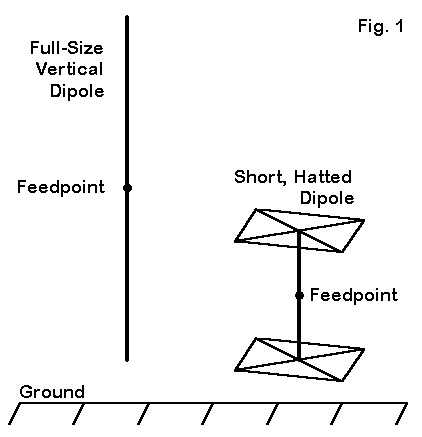
Figure 1 shows a very short hatted vertical dipole next to its full-size counterpart. In free space, the hatted dipole has a gain of only 0.35 dB less than the full size dipole. Since the radiation pattern strength is a function of the current on the antenna, and since the hatted dipole preserves undisturbed the high current portion of the dipole element, it also preserves most of the dipole's far field pattern strength.
Brought near the ground, as we propose to do in this exercise, the hatted dipole shows some further far field weakening compared to the full size dipole. With a base of 10' from the ground and a feed point about 32-35' above that point, the full size dipole has a 1.3 dB gain over the hatted dipole set only 4.5' above ground with its feedpoint less than 9' above that point. The difference also shows up in the elevation angle of maximum radiation: 16 degrees for the full-size dipole vs. 26 degrees for the hatted dipole.
A triangular array of hatted vertical dipoles is capable of a forward gain of about 2.5 dBi, about 2 dB less than a similar array of full-size dipoles. Most of the gain decrease comes from the lowered height of the feedpoint and the element region immediately surrounding it. But remember that the entire hatted dipole array vertically does not even reach the feedpoint of the full size dipole array. Moreover, the array shows a gain of abut 3.6 dB over a single hatted dipole. If we can only manage short verticals, then the triangle offers significant gain and directionality over the single short vertical.
A triangular array of dipoles only 17.5' long, with bases about 4.5' off the ground, gives us something we might control mechanically without upper support requirements. We might construct the elements from 1.25" aluminum or similar material. Of course, we shall need to consider the hats for both the top and bottom ends before we are done.
For the present design, I enlarged the triangle face to about 35' for element spacing that is closer to 1/4 wavelength. The center point amid the elements is 20.25' from each element. (See last month's "3-Wire" item for details of figuring an equilateral triangle.) The reason for increasing the spacing is to broaden the operating bandwidth of the array, since shortened elements tend to decrease operating bandwidth, even with symmetrical hats which preserve operating bandwidth better than any other short element loading form.

The pattern characteristics of the triangular array remain quite good across 40 meters, as illustrated in Figure 2. The anticipated front-to- back ratio varies between 11 and 16 dB across the band, while the gain varies by less than 1/2 dB. Therefore, if the lower gain and somewhat higher elevation angle of maximum radiation are acceptable, then this array is worth further consideration.
Each element will consist of a 17.5' conductor of moderate diameter. 1.25" is a good design start, although you will use what is most conveniently obtained. You will also need insulated pipe or tubing for the center or feedpoint separator and for the base mounting support.

Figure 3 provides some of the rough details for a hatted vertical dipole. Each dipole will have a loading/beta inductor at its center. When the element functions as a reflector, the inductance loads the element to the correct electrical length for nearly optimal reflector functioning. When the element operates as a driven element, the same inductor functions as a beta match reactance. The elements are cut specifically to a length that, when set in a triangle of the size prescribed, shows a feedpoint impedance of 30-35 Ohms resistance and about 20 Ohms capacitive reactance at the center of 40 meters. The reactance at the center of each element is about 60 Ohms.
The original design used 1/8" rods for the capacity hats, with similar material used as a perimeter wire. The hat structures use an 8.4' spoke length. The large 4-spoke hats are only one possible hat design. There are numerous ways to fasten rods to the main mast. You can drill through the main element. Alternatively, you can create a bracket to both support the rods and fit over the main element. Construction details are largely a matter of locally available materials and builder comfort in using them.

The array provides three-way coverage that is essentially the same as the full size-array, as shown in Figure 4. Half-power points are separated by about 130 degrees so that little is lost to the nulls between peaks. Although the take-off angle is somewhat higher than with a full size dipole, there is considerable gain at lower angles for solid DX skip angle coverage on 40 meters. The antenna system provides full horizon coverage at a gain level similar to the fixed bi-directional gain of an optimized delta SCV.
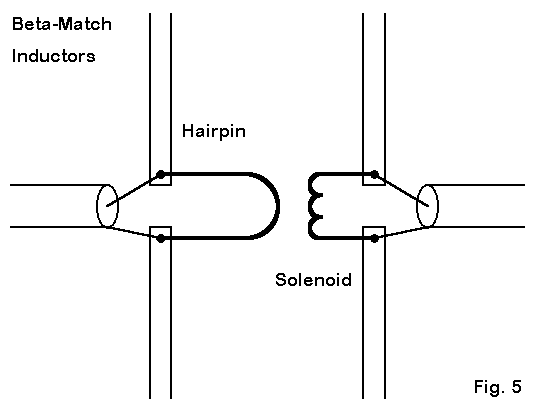
The hairpin is nothing more or less than a shorted section of parallel transmission line. You can fabricate your own, perhaps of #10 aluminum wire (to avoid bi-metallic effects at the junction). With a 2" spacing, the hairpin will need to be a little over 2.9' long. A 4" spacing between wires shortens the length to about 2.5' on the assumption of a velocity factor of 1.0 for these self-supporting lines. You may also use 450-Ohm parallel line, which would require nearly 2.8' if the velocity factor is 0.95. 300-Ohm TV ribbon with a velocity factor of 0.8 calls for nearly 3.5' of line.
For this application, a solenoid coil may be the most compact solution. There is insignificant loss if the Q is over 200, which is easily obtained from a coil that has well spaced turns and a diameter that is nearly equal to the coil length. 7 turns of #10 wire spread to a length of about 1.6" will provide adequate "squeeze and spread" adjustment range for tuning up the system.
The next step is to control the elements so that each knows when it is a reflector and when it is a driven element. For this purpose, we can use 1/4 wl sections of 50-Ohm feedline. A 1/4 wl section of RG-213, and similar lines with a 0.66 velocity factor, figures to be about 22.6' long when cut for the center of 40 meters. Since the distance from the element to the center of the triangle is 20.25', these lines leave no room for flex and might require a central control box to be mounted at the 13.25' feedpoint height--which is bound to be inconvenient. Foam lines, like RG- 8X, have a velocity factor of about 0.79, resulting in a 1/4 wl section that is about 27.2' long. This length permits a nice slope to a few feet off the ground, with a bit of flex to spare. However, I have found foam lines to vary considerably is actual velocity factor, with one batch measuring at just over 0.73. Hence, test the 1/4 wl lines you cut before using them.
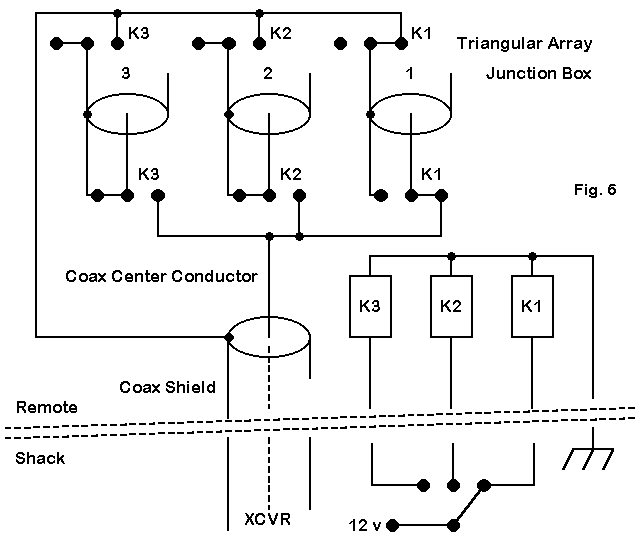
The other two 1/4 wl lines are shorted at the control box and not connected to either the center conductor or the braid of the shack feedline. When shorted at the control box, a quarter wavelength line section show a very high impedance--essentially an open circuit--at the element end. Now the coils at the center of each element provide continuity for the element and load it to the correct electrical length for use as a reflector.
Switching directions is as easy as with the full-size array. However, be sure to note the different electrical principles involved for the full and short arrays. All switches look alike, but what they switch may be very different things.
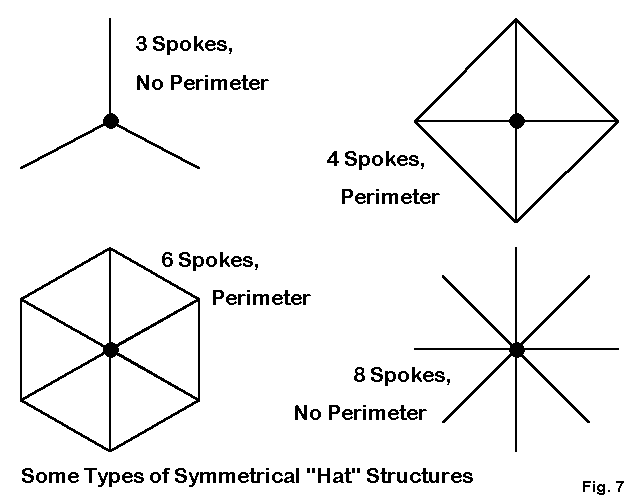
However, hats come in many variations, from as few as 2 spokes set precisely in opposite directions to 60 or more symmetrically spaced spokes. As Figure 7 shows, the design may use spokes only or use a connecting wire from tip-to-tip. Each of these hats is symmetrical so that the radiation from one part is cancelled by radiation from elsewhere in the hat.
The relationship of the spoke length (which establishes a virtual hat "radius") and the number of spokes is quite regular, although not simple. First, spokes are shorter, for any set number of them, if a perimeter wire is employed. The true element end is not at the tip of the spoke, but half way between spokes on the perimeter wire. Very roughly, the effective spoke length is the sum of the spoke and the half-length of perimeter wire.
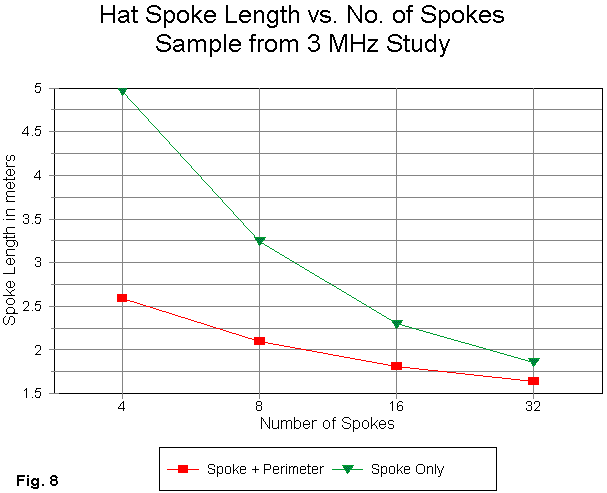
Figure 8 shows a graph of what happens to the required spoke length as the number of spokes is increased--for both the spoke-only design and for the spoke-plus-perimeter-wire design. Although this study was done at 3 MHz, the trends are perfectly applicable at any HF frequency. For small numbers of spokes, the perimeter wire shortens the hat radius fully by half. However, as the number of spokes increases, the shrinkage benefit of the perimeter wire is reduced, since the length between tips is much shorter.
At the same time, more spokes means shorter spokes, but probably not beyond a limit of about 60 spokes, when the system begins to simulate a solid disc. You can draw out both curves on the graph until they intersect and level well beyond the right edge of the graph. Notice also that there is a minimum spoke length limit. This limit is about 70% of the spoke length of the 4-spoke-plus-perimeter design. Hence, for the triangular do not expect spokes much less than about 5.5' long, no matter how many you add.
Actual spoke system construction once more is a local effort and depends on available materials and construction techniques you have mastered. You can, of course, use an insulated extension for the element to provide truss support for the upper spokes, and replicate something similar for the lower hat.
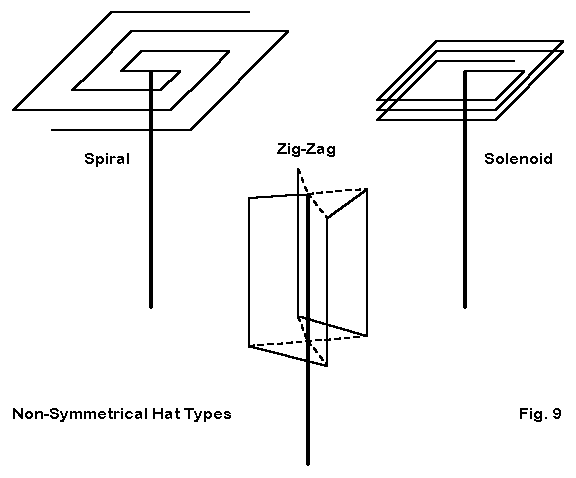
Figure 9 shows some, but by no means all, options available for non- symmetrical hat design. The spiral, if very carefully constructed, can become a nearly symmetrical hat, although coupling between different points along the same wire prevents true symmetrical hat performance.
The solenoid, shown as a large spread coil, can also be compacted into a length of wire resembling a normal inductor. However, at the high-voltage, low-current end of the element, there are radically unequal currents at the coil ends, defeating the conditions required for an inductance of appreciable magnitude. Instead, the solenoid functions as simply a length of wire so configured as to minimize its physical size and to allow the element to reach resonance. (A measure of how little the end-loading solenoid acts as an inductor can be seen by comparing the actual coil of wire required to produce resonance with an inductor that might be used as a source of inductive reactance. Inductive reactance values in the 10s of thousands of Ohms are needed near antenna element ends to effect reactive loading, while the wire coil achieves resonance with only a small fraction of the wire length needed to make a coil with the high reactance. In antennas, not everything that looks like an inductor functions as an inductor. Similar things can be said of apparent capacitors.)
The zig-zag hat is simply a variant of extending the wire outward, but bringing it inward and then back and forth (up and down for a vertical element) until resonance is achieved. (The dotted lines in the sketch represent insulated supports.) The close coupling extends the total length of wire required to make this type of hat, but the wire can be light and held within about 2' of the main element for fairly good efficiency.
Every form of non-symmetrical end loading offers both advantages and disadvantages. On the plus side is the fact that non-symmetrical end loading can result in quite compact antenna structures that are mechanically easier to fabricate and maintain. However, all such structures result in less gain, lower feedpoint impedances, and a narrower operating bandwidth for both the antenna characteristics and the feedpoint impedance. Wherever physically feasible, symmetrical hats are superior.
The short, hatted three-dipole array is certainly not for everyone with the backyard space for it. The array presents some construction challenges that may be beyond what a given situation permits. However, it does offer a number of design ideas that are worth stowing in the notebook for future reference. Hatted dipoles (and monopoles) offer superior performance to elements of equal length using other forms of loading. Elements, even with loads at their centers, can be made to perform different functions in a given array depending upon their connection--and that may be remotely controlled by fairly simple means. Triangles offer one of the least expensive steerable arrays for the lower bands.
While you may not build this array, I'll bet at least one of these ideas works its way into your future antenna construction projects.
Updated 2-5-99. © L. B. Cebik, W4RNL. This item first appeared in AntenneX, Dec., 1998. Data may be used for personal purposes, but may not be reproduced for publication in print or any other medium without permission of the author.